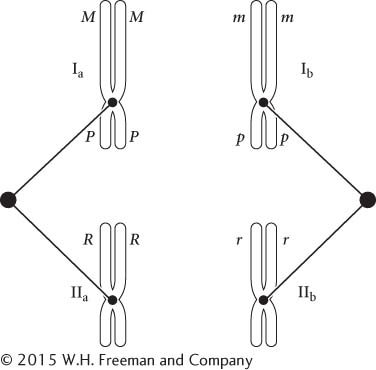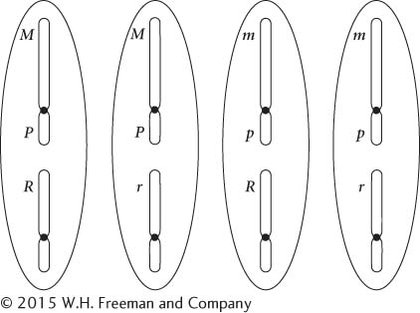Chapter 2
Stage Number of cells counted Proportion of cells at each stage Average duration (hours) Interphase 160 0.80 19.2 Prophase 20 0.10 2.4 Prometaphase 6 0.03 0.72 Metaphase 2 0.01 0.24 Anaphase 7 0.035 0.84 Telophase 5 0.025 0.6 Totals 200 1.0 24 Average duration of M phase is 4.8 hours.
12 chromosomes and 24 DNA molecules
12 chromosomes and 24 DNA molecules
12 chromosomes and 24 DNA molecules
12 chromosomes and 24 DNA molecules
12 chromosomes and 12 DNA molecules
6 chromosomes and 12 DNA molecules
12 chromosomes and 12 DNA molecules
6 chromosomes and 6 DNA molecules
6 chromosomes
First cell: anaphase I of meiosis
Second cell: anaphase of mitosis
Third cell: anaphase II of meiosis
First cell: 6 chromosomes and 12 DNA molecules
Second cell: 12 chromosomes and 12 DNA molecules
Third cell: 6 chromosomes and 6 DNA molecules
Stage of mitosis Amount of DNA per cell (a) G1 d 3.7 pg (b) Prophase I a, f 7.3 g (c) G2 b, c, e 14.6 pg (d) Following telophase II and cytokinesis (e) Anaphase I (f) Metaphase II The amount of DNA in the cell will be doubled after the completion of the S phase and prior to cytokinesis in either mitosis or meiosis I. At the completion of cytokinesis following meiosis II, the amount of DNA will be halved.
G1 occurs prior to the S phase and the doubling of the amount of DNA.
The amount of DNA doubles in the S phase, so during prophase I of meiosis, the amount of DNA in the cell is twice the amount in G1.
G2 takes place directly after the completion of the S phase, so the amount of DNA is twice the amount in G1.
Following cytokinesis associated with meiosis II, each daughter cell will contain only one-
half the amount of DNA of a cell found in G1 of interphase. During anaphase I of meiosis, the amount of DNA in the cell is twice the amount in G1.
In metaphase II of meiosis, the amount of DNA in each cell is the same as G1 because the DNA doubled in the S phase but then was reduced by half in the first meiotic division.
The progeny of the organism whose cells contain the larger number of homologous pairs of chromosomes should be expected to exhibit more variation. The number of different combinations of chromosomes that are possible in the gametes is 2n, where n is equal to the number of homologous pairs of chromosomes. For the fruit fly, which has four pairs of chromosomes, the number of possible combinations is 24 = 16. For the house fly, which has six pairs of chromosomes, the number of possible combinations is 26 = 64.
Metaphase I

Gametes

Cell type Number of chromosomes Number of DNA molecules (a) Spermatogonium 64 64 Assuming the spermatogonium is in G1 prior to the production of sister chromatids in the S phase, the chromosome number will be the diploid number of chromosomes. (b) First polar body 32 64 The first polar body is the product of meiosis I, so it will be haploid; but the sister chromatids have not separated, so each chromosome will consist of two sister chromatids. (c) Primary oocyte 64 128 The primary oocyte has stopped in prophase I of meiosis. So the homologs have not yet separated, and each chromosome consists of two sister chromatids. (d) Secondary spermatocyte 32 64 The secondary spermatocyte is a product of meiosis I and has yet to enter meiosis II. So the secondary spermatocyte will be haploid because the homologous pairs were separated in meiosis I; but each chromosome is still composed of two sister chromatids.
No, the information is not identical with that found in the secondary oocyte. The first polar body and the secondary oocyte are the result of meiosis I, which produces two nonidentical cells. The first polar body and the secondary oocyte will contain only one member of each original chromosome pair. Additionally, crossing over that took place in prophase I will have generated new and different arrangements of genetic material on those chromatids that participated in crossing over.
No, the information is not identical. The second polar body and the ovum will contain copies of the same members of the homologous pairs of chromosomes that separated in meiosis. However, because of crossing over, the sister chromatids that separated in anaphase II and gave rise to the ovum and second polar body are no longer identical.
Most male animals produce sperm by meiosis. Because meiosis takes place only in diploid cells, haploid male bees do not undergo meiosis. Male bees can produce sperm, but only through mitosis. Haploid cells that divide mitotically produce more haploid cells.